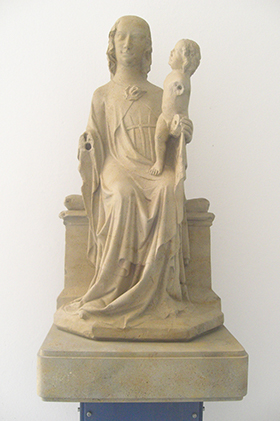German Marian Statues
Symbols of Suffering and Hope
 Depictions of Mary found in the Munich Motherhouse have special meaning for the congregation.
Depictions of Mary found in the Munich Motherhouse have special meaning for the congregation.
The “Angermadonna” depicts Jesus sitting on Mary’s lap. The sculpture was made of sandstone (freestone) in the Rhineland Palatine about the year 1340. This copy is in the Anger cloister (the Munich Motherhouse is located on “Anger.”) The original is in the Bavarian National Museum in Munich. According to the tradition of the Anger, the “Angermadonna” was a personal gift of Emperor Ludwig I, (+1343) whose daughter Agnes entered the Convent of the Poor Clares. Giving a Marian statue as a dowry for a princess was in accord with her status of nobility and emphasized the tradition of Marian devotion in her father’s house. (House of Wittelsbach) Sometimes the lack of arms on statues was helpful in “dressing” them for various feasts.
The statue of Our Sorrowful Mother was originally in the Convent of the Poor Clares, established by the Franciscans in 1221. On October 16, 1284, the Franciscans moved to another part of Munich and gave the convent to the Poor Clares. Many women graced this convent with their prayer and suffering. In 1803, the government confiscated the buildings and the Poor Clares “were sent to Dietramszell where they were sentenced to extinction.”1 Louis I granted the School Sisters of Notre Dame government approval and in 1843 gave it the former Poor Clare convent on the Anger to be its Motherhouse, and remained its patron all his life.The statue of Our Sorrowful Mother has been revered for many years. It stands at the gravesite of Mother Theresa. It is a wood carving from the trunk of a pear tree created around 1651. The artist was Tobias Baader.2